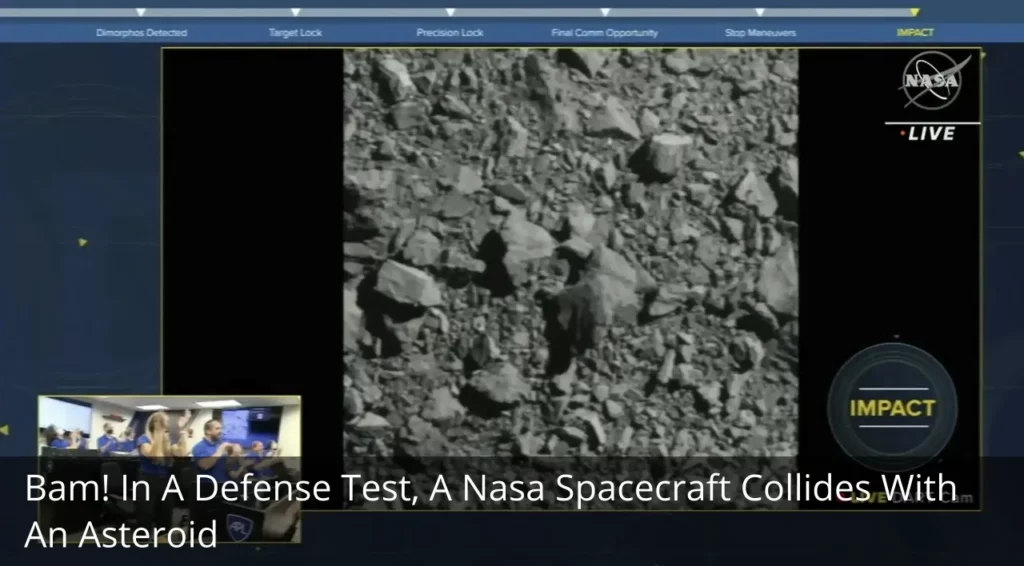CAPE CANAVERAL, FLORIDA – In an unprecedented dress rehearsal for the day. On Monday, a NASA spacecraft rammed a killer rock, threatening Earth at breakneck speed.
Dart’s Spacecraft Collided on Harmless Asteroid
Dart’s spacecraft collided with a harmless asteroid 7 million miles (9.6 million kilometers) away, plowing into it at 14,000 mph (22,500 kph). The impact was expected to create a crater and launch streams of rocks and dirt into space. Most importantly, it alters the asteroid’s orbit.
“We have an impact!” exclaimed Elena Adams, jumping up and down and thrusting her arms skyward.
Capturing the Spectacle Moment Worldwide using Telescope
To capture the spectacle. Telescopes worldwide and in space were aimed at the same sky. Though the impact was noticeable – Dart’s radio signal abruptly stopped. It will take days, if not weeks, to determine how much the asteroid’s path was altered.
“Now comes the science,” said Lori Glaze, director of NASA’s planetary science division. “Now we’ll see how effective we were in real life.”
The $325 million mission marked the first attempt to move an asteroid or other natural object in space.
“What a wonderful thing! That capability has never been available to us before. “Glaze has been noted.
NASA Administrator’s Tweet
NASA Administrator Bill Nelson had earlier in the day tweeted, “No, this is not a movie plot.” “We’ve all seen it on movies like ‘Armageddon,’ but the real-life stakes are high,” he added in a pre-recorded video.
Thank you, DART.
In the coming weeks we'll learn more about exactly what occurred during this successful impact – and what it can teach us about #PlanetaryDefense techniques.
Find more about the #DARTMission and asteroids at https://t.co/3gY7dr3mLv pic.twitter.com/j8OBSQxkOG
— NASA Solar System (@NASASolarSystem) September 27, 2022
Monday’s target is Dimorphos, a 525-foot (160-meter) asteroid. It’s a moonlet of Didymos, Greek for twin, a fast-spinning asteroid five times the size of the junior partner that flung off the material that formed the junior partner.
The pair has been orbiting the sun for eons without threatening Earth. We are making them ideal candidates for save-the-world tests.
Johns Hopkins University’s Applied Physics Laboratory’s Experiment
Dart, short for Double Asteroid Redirection Test, was launched last November and navigated to its target using new technology developed by Johns Hopkins University’s Applied Physics Laboratory, the spacecraft builder and mission manager.
Dart’s onboard camera, a critical component of this intelligent navigation system, detected Dimorphos less than an hour before impact.
“Woo hoo!” exclaimed Adams, a Johns Hopkins mission systems engineer. “We’re seeing Dimorphos, which is fantastic.”
Adams and other ground controllers in Laurel, Maryland, watched with growing excitement as Dimorphos loomed more significant and prominent in the field of view alongside its larger companion, with an image beaming back to Earth every second. Dimorphous was alone in the photos within minutes; it resembled a giant gray lemon with boulders and rubble on the surface. As the radio transmission ended, the last image on the screen froze.
Dart team: Spacecraft’s Demise
Flight controllers clapped, hugged, and exchanged high fives. After completing their mission, the Dart team went straight into celebration mode. There was no outpouring of grief over the spacecraft’s demise. “It’s coming to its end,” said Betsy Congdon, mechanical lead at Johns Hopkins.
A mini satellite followed a few minutes later to photograph the impact. Dart released the Italian Cubesat two weeks ago.
Dart, according to scientists, would not shatter Dimorphous. Compared to the asteroid’s 11 billion pounds, the spacecraft weighed only 1,260 (570 kilograms) (5 billion kilograms).
Scientists noted the Expected Orbital Shift
However, that should be enough to reduce its 11-hour, 55-minute orbit around Didymos.
The impact should cut that time by ten minutes, but telescopes need anywhere from a few days to nearly a month to confirm the new orbit. Scientists noted that the expected orbital shift of 1% may not appear significant. However, they emphasized that it would be a substantial change over time.
Given enough lead time, planetary defense experts prefer nudging a threatening asteroid or comet out of the way rather than blowing it up and creating multiple pieces that could rain down on Earth. For large space rocks, multiple impactors or a combination of impactors and so-called gravity tractors, which are yet-to-be-invented devices that use their gravity to pull an asteroid into a safer orbit, may be required.
“The dinosaurs didn’t have a space program to help them know what was coming. But we do,” NASA’s senior climate adviser Katherine Calvin said. She refers to the 66 million-year-old mass extinction thought to have been caused by a significant asteroid impact, volcanic eruptions, or both.
Dart to Protect Earth from Asteroid Strikes
Since its inception by astronauts and physicists 20 years ago, the non-profit B612 Foundation has advocated for impact tests like Dart to protect Earth from asteroid strikes. Aside from Monday’s accomplishment, the world needs to identify better the countless space rocks lurking out there, warned the Foundation’s executive director, former astronaut Ed Lu.
According to NASA, less than half of the estimated 25,000 near-Earth objects in the lethal 460-foot (140-meter) range have been discovered. And only a fraction of the millions of more minor asteroids capable of causing widespread damage is known.
According to Lu, the National Science Foundation, and the US Energy Department’s Vera Rubin Observatory. Which is nearing completion in Chile, and promises to revolutionize the field of asteroid discovery.
Asteroid discovery and tracking “That remains the goal in this situation. That is what must occur to protect the Earth, “He stated.

